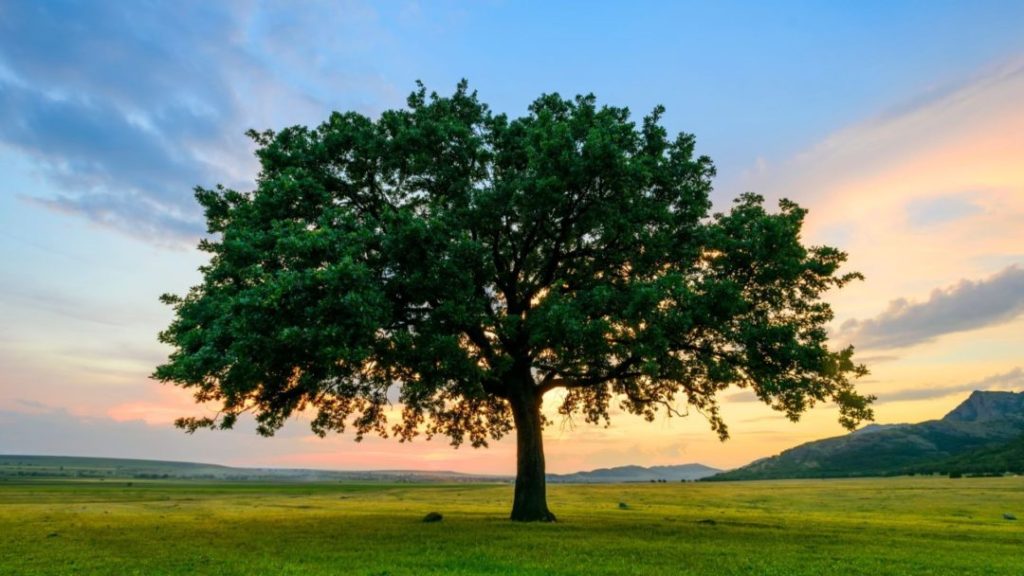Table of Contents
TREE LESSON PLANS
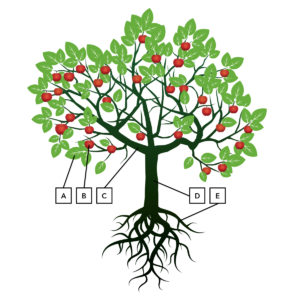 |
Talk About Trees is a collection of nine downloadable lesson plans (with printable worksheets) on such topics as the forest food web, photosynthesis, the water cycle, the carbon cycle, and forest natural disasters. Included are activities, games, and lists of additional resources. Targeted at elementary-level kids. |
| From Penn State, Forestry/Natural Resources Lesson Plans is an extensive collection, variously for grades K-5. Titles include Forest Stewardship, The History of Maple Syrup, Seasons of Trees, Trees and Their Parts, Tree Growth, Trees to Paper, Leaf Identification, and Build a Forest. | |
| From Education World, Trees Sprout Classroom Lessons Throughout the Year is a collection of five detailed lessons about trees. How Does Your Tree Measure Up?, for example, is a math-based lesson for grades 3-12 in which kids calculate the height of a tree, the area of its leaf cover, the number of leaves on the tree, the average size of a leaf, and more. | |
| The Rainforest Alliance Curriculum has detailed lesson plans for grades K-8 with many downloadable resources. Topics covered include rainforest trees and animals, coffee and chocolate, biodiversity, deforestation, and more. | |
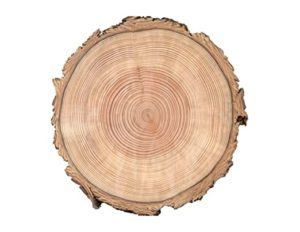 |
It’s All in the Rings is a lesson plan for middle- and high-school-level students on tree growth. |
FICTIONAL TREES
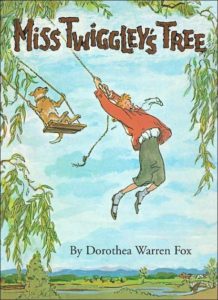 |
By Dorothea Warren Fox, Miss Twiggley’s Tree (Purple House Press, 2002) – originally published in 1966 – is a perfect delight. Told in bouncy rhyme, it’s the story of the shy and unconventional Miss Twiggley who lives in a tree with her dog and some supportive bears. (“Funny Miss Twiggley/Lived in a tree/With a dog named Puss/And a color TV./She did what she liked and she liked what she did/But when company came/Miss Twiggley hid.”) When the town is flooded, however, Miss Twiggley (and bears) come to the rescue. For ages 3 and up (and up). |
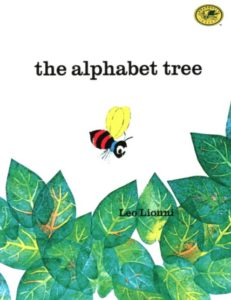 |
In Leo Lionni’s The Alphabet Tree (Alfred A. Knopf, 1990), each letter has a favorite leaf on the alphabet tree – until a gale-force wind swoops in and blows them all over the place. The solution is cooperation, as the letters band together to form words. For ages 3-7.
Try making your own alphabet tree! |
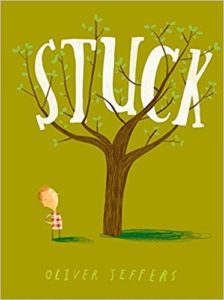 |
In Oliver Jeffers’s Stuck (Philomel, 2011), when Floyd’s kite becomes stuck in a tree, he hurls things after it, which all become stuck in turn – shoes, the kitchen sink, a boat, a rhinoceros, a lighthouse, a whale. Hilarious for ages 3-7. |
| Listen to Stuck read by Oliver Jeffers on YouTube. | |
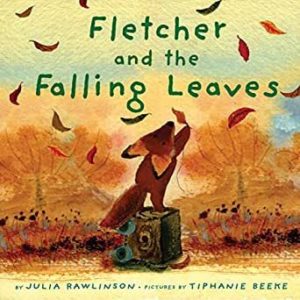 |
In Julia Rawlinson’s Fletcher and the Falling Leaves (Greenwillow, 2008), Fletcher – an adorable little fox – is convinced that his favorite tree is sick: its leaves are turning brown. His mother assures him that this is normal in autumn, but frantic Fletcher isn’t convinced, and as the leaves inevitably fall, he does his best to stick them back on the tree. Finally, despite his best efforts, the last leaf falls – but when Fletcher next visits his tree, he finds it covered with glittering (with real sparkle) icicles that laugh happily when Fletcher asks the tree if it is all right. For ages 4-7. |
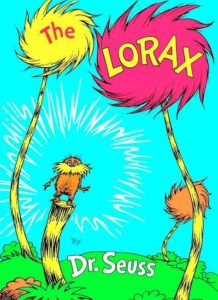 |
Dr. Seuss’s The Lorax (Random House, 1971) – which features the Lorax, who speaks for the trees – may be everyone’s all-time favorite environmental picture book. For ages 4-8. |
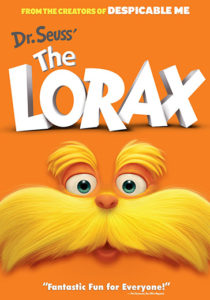 |
The 2012 movie version of The Lorax is rated PG. |
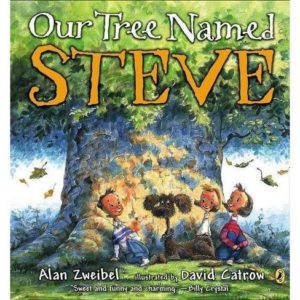 |
In Alan Zweibel’s Our Tree Named Steve (Puffin, 2007), Steve, the tree, is felled by lightning and the family recalls all that Steve has meant to them over the years, providing everything from a swing to a camp site to a hammock stand for fat Uncle Chester to a meeting place for young lovers. At the end, Steve’s wood becomes a playhouse. Love and loss, with gentle humor, for ages 4-8. |
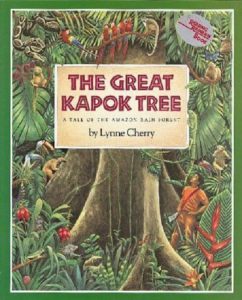 |
Lynne Cherry’s The Great Kapok Tree (Houghton Mifflin Harcourt, 2000) is the story of a man who has come to the rain forest to chop down the great kapok tree, but instead falls asleep at its foot. As he sleeps, animal after animal arrives to plead for the life of the tree – snakes, monkeys, birds, frogs, butterflies, and a jaguar all join in – and when the man awakes, now knowing the importance of the tree to so many creatures, he shoulders his ax and walks away. A beautiful and thought-provoking picture book for ages 4-8. |
| Find out about the kapok tree and more from the Rainforest Alliance. | |
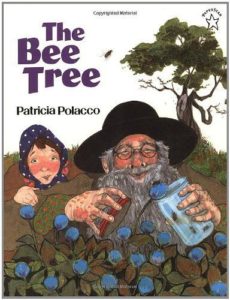 |
In Patricia Polacco’s The Bee Tree (Puffin, 1998), Mary Ellen is tired of reading and wants to go outdoors – so her grandfather decides that it’s the perfect time to hunt for a bee tree. Soon they’ve gathered a crowd of people and animals following behind them, all out to find some honey. (There’s also a nice little moral at the end about the joys of reading.) For ages 4-8. |
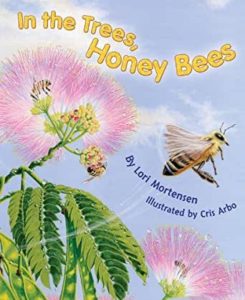 |
Lori Mortensen’s In the Trees, Honey Bees! (Dawn Publications, 2009) is a simple rhyming account of the life of a wild bee colony living in a bee tree; fact boxes provide more information for older children. For ages 4-7. |
| For more resources, see The Buzz on Bees. | |
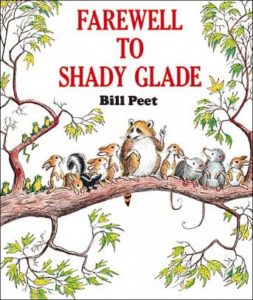 |
In Bill Peet’s Farewell to Shady Glade (Houghton Mifflin Harcourt, 1981), a host of forest animals, led by a raccoon, are about to lose their home to land developers with bulldozers. They set out by train to find a new home. For ages 4-8. |
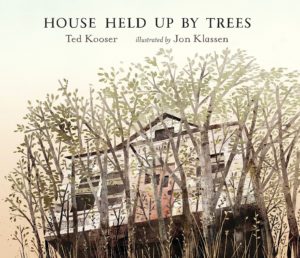 |
In Ted Kooser’s House Held Up by Trees (Candlewick, 2012), a man struggles to keep his yard free of tree seedlings, while his children play in the woods adjoining his property. Finally the children grow up, the man leaves the house, and the property is abandoned – at which point the trees take over and slowly, inexorably, surround the house, hold it together, and lift it off the ground. A story of the power of the wild for ages 4-9. |
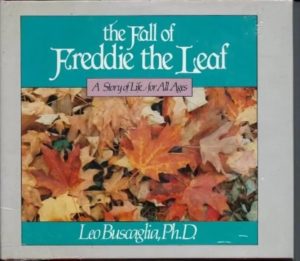 |
Leo Buscaglia’s The Fall of Freddie the Leaf (Slack, Inc., 1982) is a gentle explanation of the nature of death, through the tale of Freddie, a leaf whose time has come to fall. For ages 4 and up. |
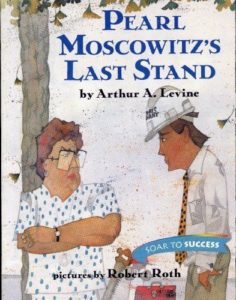 |
In Arthur Levine’s Pearl Moscowitz’s Last Stand (Houghton Mifflin, 2000), feisty Pearl goes into action when the city threatens to cut down the last lone gingko tree on her multicultural urban block. For ages 5-8. |
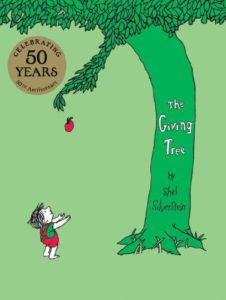 |
The star of Shel Silverstein’s The Giving Tree (Harper & Row, 2014) is a kind and generous tree who loves a little boy. At first, he plays with her leaves and climbs on her branches; then as he grows older, he demands more and more from the tree: her apples to bring him money; her branches to build a house; her trunk to build a boat. Finally, the man is old and the tree has nothing more to give him – except her stump, which provides a place to sit. There he sits, “and the tree was happy.” A discussion-promoter for ages 5 and up. |
| See The Giving Tree on YouTube narrated by Shel Silverstein. | |
| From the Teaching Children Philosophy website, The Giving Tree page has a summary, background guidelines for philosophical discussion, and a list of questions for readers. | |
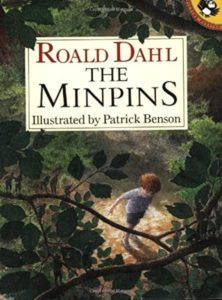 |
In Roald Dahl’s The Minpins (Puffin, 2009), Little Billy – despite awful warnings from his mother – goes into the Forest of Sin where, living in the tops of the trees, he discovers the Minpins, an entire village of miniature people who scamper around in the branches wearing little green boots equipped with suction cups. They are terrified by a monster, the Red-Hot Smoke-Belching Gruncher, and when Billy manages to dispatch it, he ends up with a liberating reward (magical nightly rides on the back of a swan). For ages 5-9. |
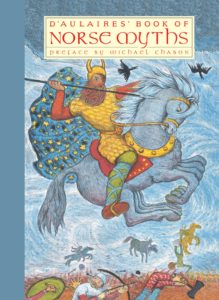 |
By Ingri and Edgar Parin D’Aulaire, D’Aulaires’ Book of Norse Myths (New York Review Children’s Collection, 2005) is a marvelously illustrated collection of tales of Norse gods, goddesses, and giants, including the story of Yggdrasil, the World Tree. For ages 5 and up. |
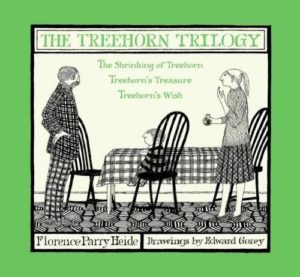 |
In Florence Parry Heide’s Treehorn’s Treasure (Pomegranate, 2011), Treehorn stashes his allowance in a hole in a tree and discovers that the tree is now sprouting dollar bills. His parents, however, refuse to believe him. Heide’s Treehorn stories are gems, starring the commonsensical Treehorn, who deals calmly with fantastic situations, and his oblivious parents. With great illustrations by Edward Gorey. For ages 7 and up. |
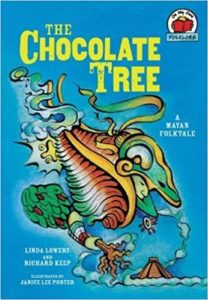 |
Linda Lowery’s The Chocolate Tree (Millbrook Press, 2009) is a retelling of a Mayan folktale about how the god Kukulkan brought the gift of chocolate to the people – in spite of the protests of the other gods, notably Kukulkan’s brother, Night Jaguar. For ages 7-10. |
| For more on chocolate and the chocolate tree, see Robert Burleigh’s nonfiction Chocolate: Riches from the Rainforest (Harry N. Abrams, 2002). For ages 8-11. | |
| For many more chocolate resources, see Chocolate. | |
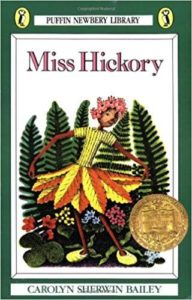 |
The main character of Carolyn Sherwin Bailey’s Miss Hickory (Puffin, 1977), which won the Newbery Award in 1947, is a doll – a notably cross and cantankerous doll – whose body is made from an apple-wood twig and head from a hickory nut. Left behind when her owners move to Boston, Miss Hickory must fend for herself during the cold New Hampshire winter. She does so, with the help of assorted animals, and even eventually begins to amend her not-always-admirable ways. At the end, however – SPOILER – a squirrel eats Miss Hickory’s head, at which point she has an epiphany about the meaning of her life; her headless twig body then wanders off and is grafted onto an apple tree, where it begins to grow. Many people love this book; I have mixed feelings about it, having been horrified when I was eight by Miss Hickory’s sudden end. A discussion-promoter for ages 7-12. |
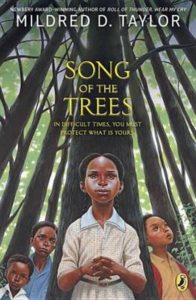 |
In Mildred D. Taylor’s Song of the Trees (Puffin, 2003), the Logan family of Mississippi – in a prequel to Roll of Thunder, Hear My Cry – struggles with poverty, racism, the Depression, and the absence of Papa, who has gone to Louisiana to make money working for the railroad. Cassie, however, finds comfort from the great trees that surround their house, that seem to her to sing a special song (though others say it’s just the wind). Then Mr. Andersen, a local white businessman, tries to force Cassie’s Big Ma to sell the beloved trees for lumber. For ages 8-12. |
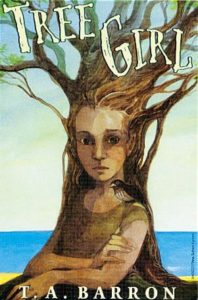 |
In T.A. Barron’s Tree Girl (Philomel, 2001), all nine-year-old Anna knows of her past is that crochety Master Mellwyn found her as a baby, lying in the roots of a willow tree. Now he warns her to stay away from the forest, which he claims is full of threatening tree ghouls – but Anna is drawn to the forest, believing it holds the secret of her mother. A short chapter fantasy for ages 8-12. |
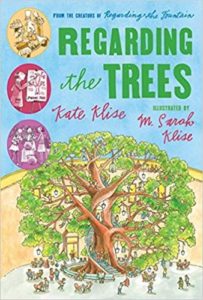 |
In Kate Klise’s Regarding the Trees (Houghton Mifflin Harcourt, 2007), the principal of Geyser Creek Middle School wants to trim trees on the school property, and so enlists the help of Ms. Florence Waters (first encountered in Klise’s Regarding the Fountain). Many misunderstandings ensue. The story is told through a creative mix of letters, announcements, newspaper clippings, and the like, with a lot of intercalated info about real trees, family trees, and Italian. For ages 8-12. |
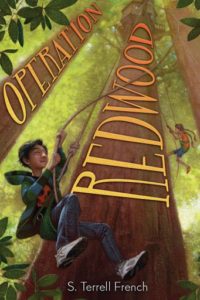 |
In S. Terrell French’s Operation Redwood (Amulet, 2011), 12-year-old Julian discovers by means of an intercepted email (calling his uncle a world-class jerk) that his uncle’s company plans to cut down a grove of old-growth California redwood trees. In company with new homeschooled friend Robin – who lives near the grove – Julian and friends embark on a campaign to save the trees. A great eco-adventure for ages 9-12. |
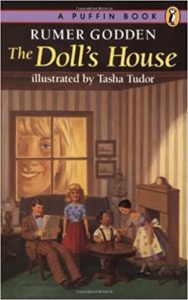 |
The star of Rumer Godden’s The Doll’s House (Puffin, 1976) is Tottie Plantagenet, a little wooden doll, who in times of trouble remembers the tree from which she was made, standing tall against the storm. (“A little of that tree is in me,” thought Tottie.) Tottie needs all her tree’s bravery and determination when she and her family run up against the elegant, but evil, Marchpane. For ages 9 and up. |
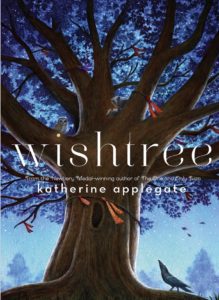 |
The narrator of Katherine Applegate’s Wishtree (Feiwel and Friends, 2018) is a tree: a red oak known as Red. Red, large-hearted and witty, is home to a host of animals – and is loved by humans who, each year, hang wishes on his branches. Then a Muslim family moves to the neighborhood and someone takes a screwdriver and carves the word LEAVE on Red’s trunk. A lovely story about tolerance, acceptance, and welcome, told by a wonderful tree. For ages 7-12. But really for everybody. |
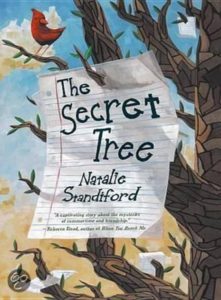 |
In Natalie Standiford’s The Secret Tree (Scholastic, 2014), ten-year-old Minty discovers the Secret Tree – a strange hollow tree filled with slips of paper holding people’s secrets. (“I put a curse on my enemy. And it’s working.”) Minty sets out to solve the mystery of the secrets, struggles to understand the strange goings-on around town (what about the weird inhabitant of the Witch House?), befriends a parentless boy named Raymond, and deals with the ups and downs of friends and family. A coming-of-age story for ages 9-12. |
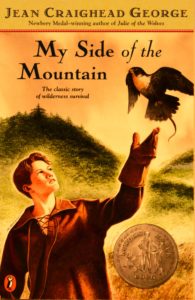 |
In Jean Craighead George’s My Side of the Mountain (Puffin, 2004), young Sam Gribley – miserable in the crowded city – runs away to the Catskill Mountains where he sets up house in a hollow tree. He copes with difficulties and dangers, makes unexpected friends – including a young falcon and a lost-in-the-woods English professor (who calls Sam “Thoreau”). A wonderful story of adventure and independence for ages 9-12. (The first of a trilogy.) |
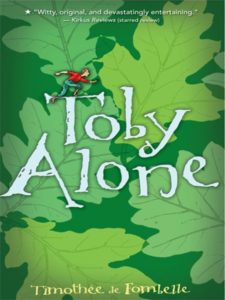 |
Toby Alone by Timothée de Fombelle (Candlewick Press, 2009) features a world of extremely small – no more than two millimeters tall – people who live in a vast oak known simply as the Tree. The tree is in political and social turmoil: thirteen-year-old Toby’s scientist parents have been captured and imprisoned, and he is alone and on the run. The root of the problem is politician/industrialist Joe Mitch, who is bent on exploiting the sap of the Tree for business purposes – a project that will inevitably kill it. Despite its minuscule characters, the book has more in common with 1984 than The Borrowers. This is a complex and sometimes violent story about the uses and abuses of power, and the consequences of environmental destruction. A thought-provoking read for ages 12 and up. The sequel – you’ll want it, since Toby Alone ends with a cliffhanger – is Toby and the Secrets of the Tree. |
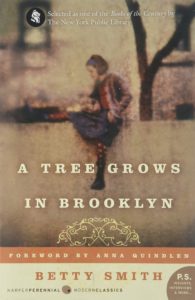 |
Betty Smith’s A Tree Grows in Brooklyn (HarperPerennial, 2006) – originally published in 1943 – is the wonderful coming-of-age story of young Francie Nolan, growing up in the slums of turn-of-the-century New York City. A recurring metaphor is that of the Tree of Heaven – the ailanthus – a tree so tough and determined that it manages to sprout and thrive in the unwelcoming cement of city streets. For ages 13 and up. |
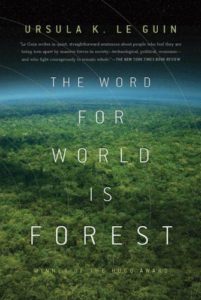 |
In Ursula K. LeGuin’s The Word for World is Forest (Tor Books, 2010), humans have taken over the tree-covered planet of Athshe, whose small furry green inhabitants pursue a peaceful lifestyle that involves a state of lucid dreaming – “dream-time” – and ritual singing. Enslaved by the invaders, the Athsheans finally revolt. There are analogies to the treatment of native Americans by the Europeans and to the U.S. involvement in Vietnam. A powerful book for teenagers and adults. |
| |
There are similar themes in James Cameron’s 2009 film Avatar, in which humans are exploiting the planet Pandora for a rare mineral (unobtanium) and in the process are destroying the native inhabitants, the Na’vi, tall blue-skinned humanoids who live in harmony with nature and worship the Hometree. Rated PG-13. |
